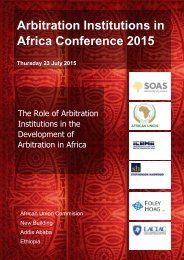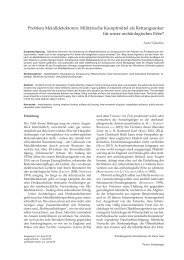Media and Minorities
9783666300882_ruhrmann_media_ebook_034247
9783666300882_ruhrmann_media_ebook_034247
You also want an ePaper? Increase the reach of your titles
YUMPU automatically turns print PDFs into web optimized ePapers that Google loves.
206<br />
Tyler Reny, Sylvia Manzano<br />
frames, metaphors, <strong>and</strong> stereotypes when talking about Latinos <strong>and</strong> immigrants,<br />
it is possible that some media <strong>and</strong> some messages have a stronger impact<br />
on respondents’ attitudes than others. Using data from an interactive online<br />
experiment, we were able to test different combinations.<br />
Participants in the experiment were r<strong>and</strong>omly assigned to one of ten<br />
groups. The first two groups received either no stimulus or a placebo. The remaining<br />
respondents either watched a positive or a negative or movie clip<br />
(entertainment prime), watched a positive or a negative TV news story (TV<br />
news prime), listened to a positive or a negative radio clip (radio prime), or<br />
read a positive or a negative print article (print prime).24 Following the prime,<br />
respondents answered questions on their views about Latinos, immigrants,<br />
<strong>and</strong> the media. We focus on comparing those who received positive primes<br />
<strong>and</strong> negative primes below.<br />
Positive Stereotypes<br />
Looking first at media <strong>and</strong> positive stereotypes, respondents who were exposed<br />
to positive primes were more likely to agree that positive stereotypes<br />
applied to Latinos than those who were exposed to negative primes. The pattern<br />
held across the positive stereotypes. In Figure 8, we present the percentage<br />
point difference between those given the positive prime who agree with<br />
the stereotype <strong>and</strong> those given the negative prime who agree. We see that the<br />
primes have large effects on respondents’ perceptions of Latinos as honest,<br />
neighborly/welcoming, <strong>and</strong> patriotic.<br />
Negative Stereotypes<br />
We find that media-message primes have an equally large <strong>and</strong> consistent effect<br />
on beliefs in negative stereotypes. As Figure 9 shows, the negative prime effectively<br />
heightens beliefs in negative stereotypes across every media type for every<br />
stereotype. As with the positive stereotypes above, we see that television news<br />
has the strongest effect in priming attitudes about Latinos <strong>and</strong> immigrants followed<br />
by talk radio. We also notice that even non-authoritative popular entertainment<br />
has the power to color attitudes towards Latinos <strong>and</strong> immigrants.<br />
24 Because the NHMC/Latino Decisions study used actual media clips, the positive/negative<br />
treatments for each media type are somewhat different, not a simple manipulation of<br />
language or frame across each media type. Thus, we are comparing how subjects respond<br />
to real-world media clips, not laboratory-controlled experimental manipulations. What<br />
internal validity we lose from the lack of a perfectly controlled environment we gain back<br />
through the use of real-world stimuli.<br />
© 2016, V<strong>and</strong>enhoeck & Ruprecht GmbH & Co. KG, Göttingen<br />
ISBN Print: 9783525300886 — ISBN E-Book: 9783666300882







